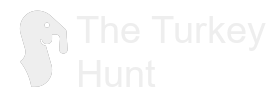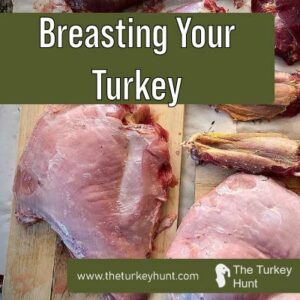We cover all aspects of hunting here at The Turkey Hunt. After you shoot your bird, we highly recommend breasting your wild turkey so you can eat it later. Hunting wild turkey can really be a rewarding experience for most people, but properly preparing the bird for cooking can be a real challenge. Most of us know that the breast meat is the most sought after part of the turkey. This guide will show you how to breast a wild turkey quickly, and efficiently.
Keep in mind that these instructions are for wild turkey and not domestic turkey. If you want to learn how to cut up your butterball, go ask Paula Dean. We’re turkey hunters, baby.
What You’ll Need
- A sharp knife
- A cutting board
- Game shears or kitchen shears
- A wild turkey
Step 1: Field Dress the Turkey
The first step in preparing a wild turkey is to field dress it. Field dressing refers to the way you clean up the bird without having to have access to a full kitchen. This process involves removing the internal organs and cleaning out the main internal cavity of the bird where the organs sit.
Begin by cutting a small hole in the skin at the base of the breastbone (just below the bottom of the sternum).
Now, carefully cut around the circumference of the anus and remove it.
Next, cut through the skin and muscle to remove the crop. The crop is located at the base of the Turkey’s neck. It is a thin transparent sack – unless there is food in it.
Be sure to avoid cutting into the stomach and intestines, because you don’t want that fluid to run over any portion of the meat.
Finally, carefully cut around the diaphragm and remove the organs.
You may not do this in the most efficient way possible your first few times, but you’ll get the hang of it. Just focus on preserving the breast meat as much as possible. This is the best part!
Step 2: Remove the Wings
Once the turkey is field dressed, the next step is to remove the wings. Cut through the skin and meat at the base of the wing. Use a lot of pressure and cut through the base joint of the wing. You should be able to get your knife in the joint without too much effort. Pop the joint, and continue cutting through to get the wing off.
Repeat this process on the other wing.
Step 3: Remove the Legs
Removing the legs is similar to the wings, but the joints are a bit larger. To remove the legs, begin by cutting through the skin and meat at the base of each of the turkey’s legs. Then, cut through the joint that connects the leg to the body (just like you did the wing), and remove the leg. Repeat this process on the other leg.
Step 4: Remove the Breast Meat
The final step in preparing your wild turkey is to remove the coveted breast meat. This is the part you want to be extra careful in.
Begin by cutting through the skin and meat at the base of the breastbone, near the body of the turkey.
Then, use your knife to carefully cut along the breastbone, separating the breast meat from the bone. Try not to leave too much extra meat on the ribcage. Once the breast meat is removed, set it aside.
Tips and Tricks to Preparing Your Bird
- Always use a sharp knife to make clean cuts and minimize waste
- When field dressing the turkey, be sure to remove all of the organs and clean out the cavity thoroughly – without getting intestinal fluid everywhere. Take your time.
- Be cautious when cutting through the breastbone. It is surprisingly thin.
- Keep the turkey cool (on ice if you can) until you can process it.
Summary – Breasting Your Turkey
Breasting a wild turkey is a relatively simple process. Hunters can do this with only a sharp knife and a little bit of practice. By following the steps outlined in this guide, you can quickly and efficiently prepare a wild turkey for cooking, and enjoy the delicious taste of your freshly killed bird. Remember that proper handling and processing of wild game is important for food safety. Do your research and take necessary precautions, especially when serving to others. Always practice safety when handling wild game and firearms.

